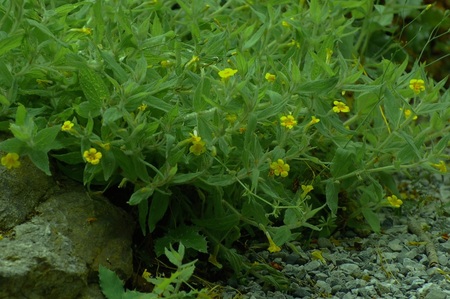 Musk-Flower's (Mimulus moschatus) common name is a reminder of a botanical mystery. Called Musk-flower, or sometimes simply Musk, it was imported to Europe from Western North America as an ornamental plant and grown for its perfumed flowers and foliage. So common was its cultivation in Victorian England that the scent of Musk-flower pervaded towns in the evening. Then in the early 1900's the species suddenly became scentless- both in Europe and in North America. Searching for scented forms has failed to find one. The cause of this peculiar phenomenon has never been explained. Our Musk(less)-flower is dervied from a cutting I took from a plant growing in a ditch along the Galloping Goose Trail. We planted it in the gravel beds alongside the stream we built in the garden. This clearly is a spot to its liking since it has spread aggresively by long underground runners and would take over the entire stream if it wasn't for the several wheelbarrow loads we take to the compost heap each summer. Seedlings pop up around the edge of the pond often, and usually I weed them out - but not before I sniff to see if one of them has re-found the ability to produce the famous musk scent.
0 Comments
Oxeye Daisy is a widespread, common introduced plant,found in meadows, fields, and disturbed areas. Formerly this was considered to be a species of Chrysanthemum. That genus has been split into several genera and this is now called Leucanthemum vulgare, which is greek for "white flower". It is a short-lived perennial with very long lasting flowers. Because the species is so widespread it has a multitude of common names besides the one we are using here, includingMoon-Daisy, Moon Daisy, Marguerite, Oxeye Daisy, Dog-daisy, and Dog Daisy. It is seldom eaten by cows and since it can become quite common in hay fields and pastures it is regarded as an important agricultural weed.
Now I've never tried these, but I'm curious, I see that the buds are being picked and pickled and sold as Ox-eye Daisy Capers http://www.wildfoods.ca/products-vegetables-ox-eyedaisycapers.html). 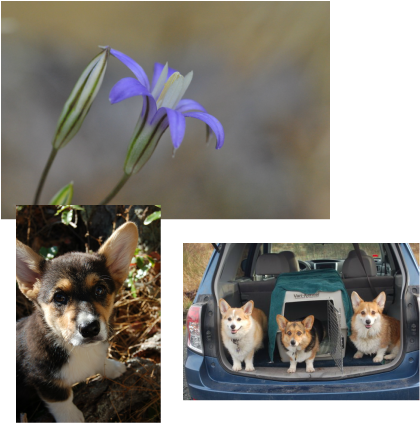 These aren't Brodiaea, but fine examples of short legs. These aren't Brodiaea, but fine examples of short legs. This is another of the perennial herbs that arise from a bulb like corm and are found in the driest of spots in western North America. The purple-blue flowers of Brodiaea coronaria are atop a smooth stalk about 10-30cm tall. There are much shorter species of Brodiaea and those are what we named our first corgi after for their short and stocky "legs". The fact sheet from the Garry Oak ecosystems restoration team: http://www.goert.ca/propagation_guidelines/forbs/brodiaea_coronaria June 9-15 was BC Invasive Species Week, so we decided to highlight a few more of the non-native invasive species found here at Leaning Oaks. Hairy Cat's-ear ( Hypochaeris radicata ) is a yellow flowered perennial with a more or less flat basal rosette with a leafless, branched flowering stem. Flowers are superficially Dandelion-like (see 91), hence another common name of False Dandelion. Unlike Dandelion, the stems are solid and not hollow. It is a common weed of lawns, cracks in pavement and disturbed areas. Like dandelions the seeds are spread by the wind. The leaves are supposed to be hairy like the hair on a cat's ear. I clearly have not looked at enough cat's ears to see the resemblance.
And, just in; "the flowers of this weed are an important spring food for black bears on Vancouver Island". Thanks Helen! Maybe we'll get bears.... Yarrow is very complex taxonomically, but seems to be generally recognized as a single highly variable species. It is widespread through the Northern Hemisphere and found in dry locations from sea level to mountains. Achillea millefolium is used in plantings where a drought tolerant plant with a long bloom season is desired. Butterflies love it!
The genus name, Achillea is derived from Achilles, the hero of Homer's Illiad in Greek mythology. He had been a student of Chiron, a centaur that was apparently renowned for his knowledge of medicinal herbs. Or it may have been that Achilles needed to use yarrow often on his wounded soldiers as they fought thier bloody battles. The list of medicinal uses for this plant is very long just locally; from the Ditidaht and Makah using it as childbirth medication, the Saanich using it in a poultice, the Nuu-chah-nulth for colds and coughs and the Cowichan as a blood-purifier, just to name a few. The species portion of the name, millefolium, means "thousand leaves" , referring to the finally segmented fern like leaves. You count and see if there are a thousand and let us know. Addendum: I thought I was done, but just found this lovely gem from http://www.arkive.org/yarrow/achillea-millefolium/.
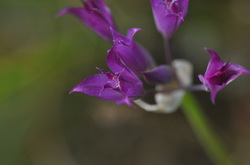 This time it really is an onion (as opposed to the Fool's Onion #121). If you step on or crush Allium acuminatum the pungent smell will leave you no doubt. The very small bulbs are occasionally eaten, but due to the restricted range it is better to stick to those locally grown Saanich Peninsula onions! There can be up to 25 flowers on a stalk, each with the tepals that turn at the tips (a distinguishing feature of A. acuminatum). Another English name I saw was "Taper-tip Onion" ; aptly descriptive. However Hooker has the honours here. Joseph Dalton Hooker was an incredibly active botanist in the 19th century, was a close friend of Darwin's, was the director of the Kew Gardens and had the best eyebrows ever. http://www.jdhooker.org.uk/ I kept calling this an onion, and then felt somewhat vindicated when I saw that one of the English names was "False Onion". It is presently Triteleia hyacinthina but is has been in the Brodiaea genus. It has no onion scent or flavour, but does grow from a bulb-like corm. It is yet another of the plants that grow in the meadow or forest edge that are adapted to the dry summers and moist winters.
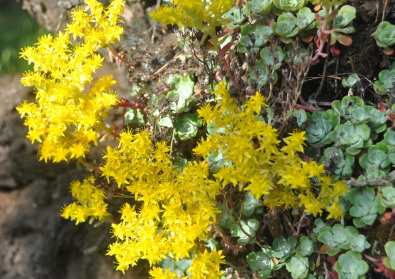 Sedum spathulifolium brightens the rock out crops, bare patches, the top of the living roof on the woodshed and does so for a long bloom period. The species name refers to the succulent leaves that form a basal rosette and that are shaped liked the tip of a thumb. It has been taken up by the horticultural trade in Europe as a rock garden plant, with good reason! There are a couple of tidbits of folklore around Midsummer's Eve (coming soon) and the longevity of the picked stalks. A stalk placed on the windowsill will turn during the night towards the direction from which your lover is to come. Another tale is that a young woman would pick two stalks; one representing herself, the other, her lover. The length of time "he" lasted was an indication of his fidelity. Beautiful, tall, the bees love them...and they are exotic. This is one of those alien European species that we let live where it grows in somewhat disturbed areas. Digitalis purpurea is a source of digitoxin, a glycoside that has been used as a heart stimulant since 1785; HOWEVER it is toxic and self medication is definitely a no no. The medical uses and early research are outlined here: http://www.kew.org/science-conservation/plants-fungi/digitalis-purpurea-common-foxglove
Common foxgloves show up regularly in folk tales as well, providing clothing for the faeries and gloves for foxes so they can creep into the chicken coop. The Miracle of the Bees and the Foxgloves BY ANNE STEVENSON Because hairs on their speckled daybeds baffle the little bees, foxgloves come out to advertise for rich bumbling hummers, who crawl into their tunnels-of-delight with drunken ease (see Darwin’s chapters on his foxglove summers) plunging over heckles caked with sex-appealing stuff to sip from every hooker its intoxicating liquor and stop it propagating in a corner with itself. And this is how the foxflower keeps its sex life in order. Two anthers—adolescent, in a hurry to dehisce-- let fly too soon, so pollen lies in drifts around the floor. Along swims bumbler bee and makes an undercoat of this, reverses, exits, lets it fall by accident next door. So ripeness climbs the bells of Digitalis, flower by flower, undistracted by a Mind, or a Design, or by desire. Creeping Buttercup (Ranunculus repens) is an aggressive introduced species that spreads by both runners and seed. At Leaning Oaks it is more or less confined to the cultivated portions of the garden (despite my efforts) and to the lawn and other disturbed areas. Fortunately, most of our meadow is too dry for Creeping Buttercup to do very well. Contact with the sap of this species can cause skin blisters, so weeding this out wearing gloves is a good idea. There is a cultivar with a yellow variegated leaf called "Buttered Popcorn" - however, it is just as invasive as the wild type and worth avoiding.
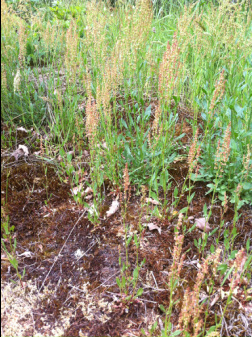 Sheep Sorrel (Rumex acetosella)is an introduced species with arrowhead shaped leaves that spreads by underground runners. The female flowers (there are separate male and female plants) are burgundy red and the plant is not unattractive when in bloom. It is a very adaptable species, and grows in a wide variety of habitats. Here it grows in cracks in the bedrock in our Garry Oak meadow. The leaves are edible, and lemony-tart and make a good addition to a salad, soup or as a component of a salad dressing. Note however that they are high in oxalic acid, which is toxic in large quantities, so use in moderation. Other common names include Red Sorrel, Common Sorrel and Field Sorrel. Baldhip Rose is the commonest wild rose on the property at Leaning Oaks. It is unusual for a rose in that is a shade tolerant species. Most roses retain the sepal crown on the bottom of the fruit (in the same way that an apple does), but this species drops this appendage and the small pear shaped fruit is smooth. The latin name, Rosa gymnocarpa refers to this; gymnocarpa means "naked fruit". The leaves can be used to make a rose tea.
Robert's Geranium (Geranium robertianum) is an introduced herbaceous weed. It is probably best known for its bright pink flowers and distinctly unpleasant smell if the foliage is crushed or bruised (earning it another common name, "Stinky Bob"). It is rumoured to be edible and has been used for a variety of medicinal uses, although at least one website cautions that there has been very little testing of side effects. It is one of the few non-native plants which can invade shady forests and I have seen it moving into some of the older forests on southern Vancouver Island.
Geranium is greek for "little crane's bill", in reference to the shape of the fruit. 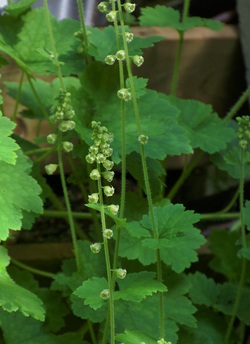 Fringecup is one of my favourite native plants. The lush basal rosette and strange recurved, filigree petals are subtle, unusual and elegant. It is, however, the perfume that these flowers produce that makes Tellima grandiflora so rewarding. This perfume brings back strong memories of my days as a park naturalist. The hill behind the visitor centre at Goldstream Provincial Park was covered in Fringecup and its perfume was a fixture during the busy days of spring school programs. Fringcup is a member of the saxifrage family and it is the only species in the genus. This makes the latin name (which means large flowered Tellima) sort of silly, since there is only one kind of Tellima. 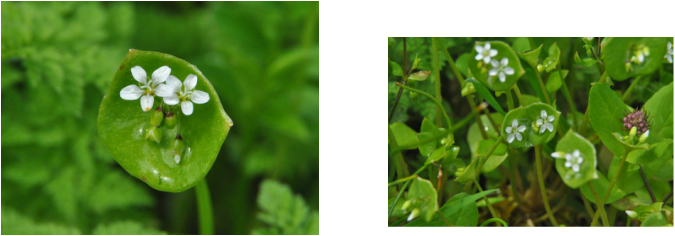 It is the two opposite leaves that are joined together forming a shallow cup that make this plant distinct. Other than that it can be quite variable depending on the moisture and soil conditions. Claytonia perfoliata ssp. perfoliata is edible and makes a bright addition to salads or anywhere that greens are desired. 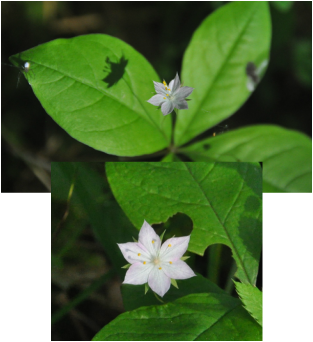 A little way from the meadow, in dappled shade and often near the base of a Douglas-fir, Trientalis borealis ssp. latifolia sports a starry flower on a oh so slender stalk--the flower appearing to float above the broad leaves. Indian Potato, another English name refers to the small, elongate pink tubers that were gathered for food by the First Nations. They are apparently a good source of starch. I am going to have to remember to go out and photograph the seed capsule - the description is that it looks like a little tiny soccer ball. 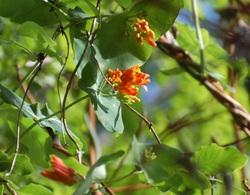 Orange Honeysuckle (Lonicera ciliosa) is one of two species of Lonicera that we have at Leaning Oaks. It is the earlier blooming of the two. Unlike moth pollinated honeysuckles, our native honeysuckle vines are pollinated by hummingbirds, and their showy flowers and large nectaries (but no perfume) are typical of hummingbird pollinated flowers. It is one of the few native vines in our area, and can climb up into the canopy of small trees. Here they grow up Garry Oaks and small Douglas-fir trees. One of the emblematic wildflowers in the Garry Oak meadow is Camassia quamash. The blue swaths begin sometime near the end of April and are usually finished by the May long weekend. The bulbs were a very important traditional food . Carbohydrates were in short supply and the bulbs were a coveted source. Fields of camas were passed on between families, the death camas "weeded" out and the ground cleared of rocks, sticks and other debris to provide the best growing conditions. The bulbs have to be cooked for long periods of time to break down the long chained inulin into something that can be digested.
It is interesting that this quote from Lewis (of Lewis and Clarke) was mid June; long after our camas have dropped all of their "blumes".
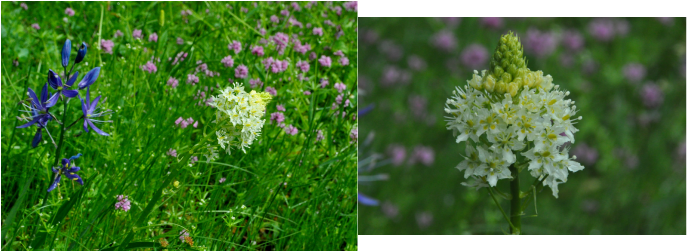 I have this image of a game of Russian Roulette where there are people out harvesting the rich bulbs of the edible blue camas and never quite knowing when they may accidentally dig up the the similar Toxicoscordion venenosum bulb that grows in the same locations, but contains the alkaloid zygacine. To avoid this, local indigenous people would remove the plants from a local harvest area when they were in bloom and more recognizable. This would make harvesting less risky! The leaves are also poisonous and have been deadly to grazing cattle in the spring where the death-camas is out before other forage is available. We have a few locations where the creamy death-camas is a lovely counterpoint to the abundant blue camas; generally in slightly moister areas. 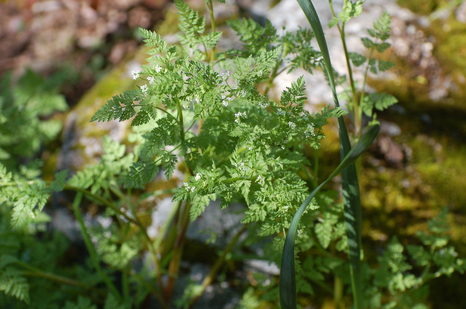 Bur Chervil (Anthriscus caucalis) is an introduced weed, similar to the garden herb, It is an aggressive colonizer in the meadow. It is a handsome plant, with fine, fern-like foliage with a strong smell when bruised or cut. The flowers are small and white. The plants here show an amazing diversity of sizes, from just a few inches high on trampled or drier sites with thin soils to robust plants over a meter high on moister, deeper soils. For the most part it seems to behave as a biennial here, forming a basal rosette the first year and flowering in the spring of the second year. |
AuthorsTwo biologists on a beautiful property armed with cameras, smart phones and a marginal knowledge of websites took up the challenge of documenting one species a day on that property. Join along! Posts and photographs by Leah Ramsay and David Fraser (unless otherwise stated); started January 1, 2014. Categories
All
Archives
May 2025
|
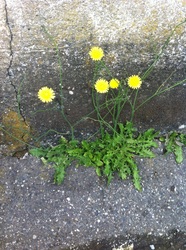
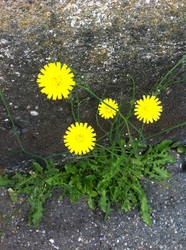
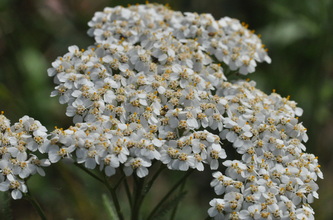
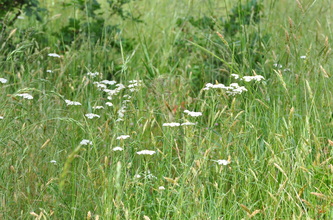
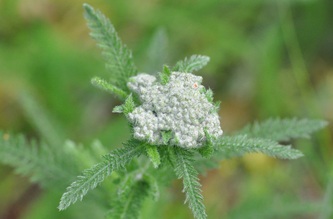
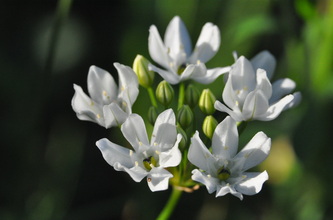
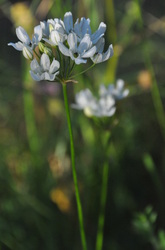
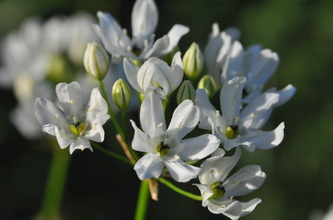
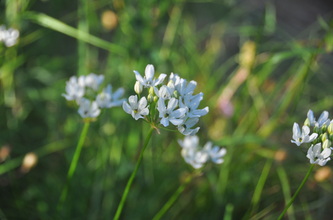
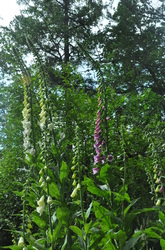
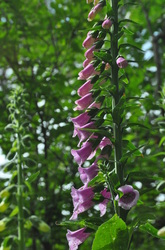
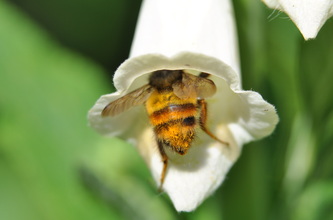
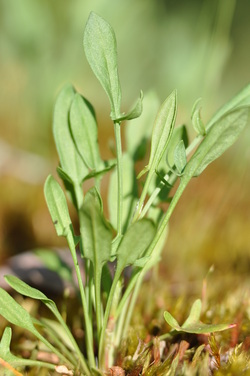
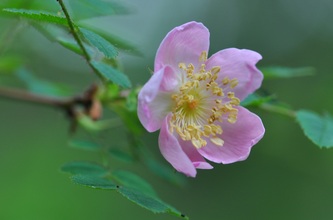
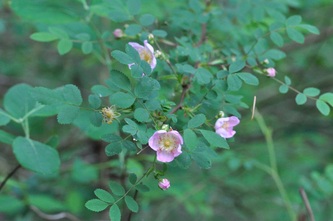
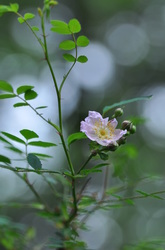
 RSS Feed
RSS Feed